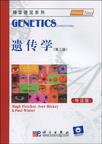遗传学
出版时间:2009-8 出版社:科学出版社 作者:(英)弗莱彻 等主编 页数:379
Tag标签:无
前言
自本书第二版出版以来,人们对遗传学的研究取得了一些重要的进展。虽然基因组测序不再属于前沿领域,但是从中所获得的数据促进了诸多的研究工作。人类基因组仅有20 000个基因被鉴定出来,估计上限为25 000个基因;这远远低于先前的预测,将人类跟其他大多数的多细胞生物紧紧地联系在一起。人类的基因数目似乎比卷心菜的还要少。基因组比对结果还显示,有67~83个在黑猩猩体内依然活跃的基因,由于在进化过程中产生突变而在人类中成为没有活性的假基因。更令人惊异的是,人类基因组的某些部分与黑猩猩的差异比其余部分大得多。这表明当祖先群体向这两个不同的物种趋异进化时经历了很长一段时间,期间发生了一些遗传交换。 另一个新进展是发现RNA在控制染色质结构方面的作用,以及组蛋白N末端的共价修饰在调节染色体结构方面的重要性。某些组蛋白修饰(例如位点特异性甲基化)能够促使核小体紧密堆积,导致形成致密的染色质,造成转录装置难以接近,从而使其中的基因的表达受到限制。双链RNA能够引导特异的DNA序列发生这种修饰,使CpG序列(在植物中为CpNpG)中的胞嘧啶被甲基化,并且这种修饰与组蛋白的去乙酰化相关。随着用以鉴定组蛋白特异修饰的单克隆抗体不断增多,人们对所谓的“组蛋白密码”的认识将会越来越清晰。 为了反映上述变化,我们减少了介绍基因组测序技术的篇幅,同时将表观遗传学移到了A单元中的“分子遗传学”部分,因为这样看起来更为恰当。人类的进化作为单独的一个单元出现。人类在地球上定居与迁移的地理学越来越清楚,而随着类人猿基因组的信息逐渐明朗,人们才刚刚开始认识人类与类人猿之间在分子水平上的差异。 有很多审稿人对本书的前一个版本提出了评论和修改建议,我们在此表示感谢。在力所能及的范围内,我们尽可能采纳了他们的建议。我们希望至少有一些审稿人对某些改动会感到满意。
内容概要
“精要速览系列(Instant Notes Series)”丛书是国外教材“Best Seller”榜的上榜教材。该系列结构新颖,视角独特;重点明确,脉络分明;图表简明清晰;英文自然易懂,被国内多所重点院校选用作为双语教材。 第三版在第二版基础上进行修订。对人类基因研究、RNA调控、组蛋白修饰、表观遗传学、人类进化等新近研究进行重点补充和调整,其他各章节也进行了修订。 本书适合普通高等院校生命科学、医学、农学等相关专业使用,也可作为双语教学参考教材使用。
书籍目录
前言缩略词A 分子遗传学 A1 DNA结构 A2 基因 A3 遗传密码 A4 基因转录 A5 转移RNA A6 核糖体RNA A7 信使RNA A8 翻译 A9 DNA复制 A10 原核生物基因表达调控 A11 真核生物基因表达调控 A12 表观遗传学与染色质修饰B 基因组 B1 染色体 B2 细胞分裂 B3 原核生物基因组 B4 真核生物基因组 B5 DNA突变 B6 诱变剂和DNA修复 B7 重组 B8 噬菌体 B9 真核生物的病毒 B10 基因组分析C 遗传机制 C1 基础孟德尔遗传学 c2 孟德尔遗传学(续) C3 减数分裂和配子形成 CA 连锁 C5 细菌间的基因转移 C6 真核生物细胞器中的基因 C7 数量遗传 C8 性别决定 C9 性别和遗传 C10 近交 C11 概率 C12 适合度检验:卡方和精确度检验D 群体遗传学与进化 D1 简介 D2 通过自然选择的进化 D3 群体中的基因:哈迪一温伯格平衡 D4 遗传多样性 D5 新达尔文进化论:选择作用于等位基因 D6 染色体在进化中的变化 D7 物种和物种形成 D8 多倍性 D9 进化 D10 人类的进化E 重组DNA技术 E1 DNA研究技术 E2 RNA研究技术 E3 DNA克隆和转染 E4 生物信息学F 人类遗传学 F1 遗传病 F2 遗传筛选 F3 基因与癌症 F4 基因治疗G 遗传学的应用 G1 遗传学在法医学中的应用 G2 生物技术 G3 转基因学 G4 伦理学问题进一步阅读的文献和有用的网站索引注:英文目录E2之后的页码错误。
章节摘录
The DNA sequence of a gene determines the amino acid sequence of its encodedprotein. It is very important that the DNA sequence is preserved because alter-ations to the amino acid sequence may affect the ability of the protein to function,which in turn may have a deleterious effect on the organism. Alterations to theDNA sequence do occur as a result of the action of a number of chemical andphysical agents on DNA and also due to rare errors in DNA replication. Thesechanges are known as mutations. Once introduced, the DNA sequence changesare made permanent by DNA replication and are passed on to daughter cellsfollowing cell division. Two important terms that describe an organism carrying a mutation are 8eno-type and phenotype. Genotype is used to describe the mutation and the gene itoccurs in. Phenotype describes the effect on the organism of the mutation. Anorganism that displays the usual phenotype for that species is called the wild-type. An organism whose usual phenotype has changed as the result of amutation is called a mutant. Mutations occur in two forms: point mutationswhich involve a change in the base present at any position in a gene, and grossmutations which involve alterations of longer stretches of DNA sequence. Thelocation of the mutation within a gene is important. Only mutations that occurwithin the coding region are likely to affect the protein. Mutations in noncodingor intergenic regions do not usually have an effect. Point mutations fall into a number of categories, each with different consequencesfor the protein encoded by the gene.Missense mutations These point mutations involve the alteration of a single base which changes acodon such that the encoded amino acid is altered (Fig. la). Such mutationsusually occur inone of the first two bases of a codom The redundancy (degen-eracy) of the genetic code means that mutation of the third base is less likely tocause a change in the amino acid. The effect of a missense mutation on theorganism varies. Most proteins will tolerate some change in their amino acidsequence. However, alterations of amino acids in parts of the protein that areimportant for structure or function are more likely to have a deleterious effect andto produce a mutant phenotype. Nonsense mutations These are point mutations that change a codon for an amino acid into a termina-tion codon (Fig. Ib). The mutation causes translation of the messenger RNA to endprematurely, resulting in a shortened protein which lacks part of its carboxyl-terminal region. Nonsense mutations usually have a serious effect on the activityof the encoded protein and often produce a mutant phenotype. Frameshift mutations These result from the insertion of extra bases or the deletion of existing bases fromthe DNA sequence of a gene. If the number of bases inserted or deleted is not amultiple of three the reading frame will be altered and the ribosome will read adifferent set of codons downstream of the mutation, substantially altering theamino acid sequence of the encoded protein (Fig. lc). Frameshift mutationsusually have a serious effect on the encoded protein and are associated withmutant phenotypes.
编辑推荐
快速、准确掌握专业知识和专业外语的最佳套书!一种对教材概念的新的诠释! 精炼学科核心内容,以相对独立又互相关联的专题形式介绍各学科基础知识。 版式设计独特,方便学生快速、便捷地领会学科要点,便于复习与记忆。 编写风格统一,提供“结构化”学习方法。 世界范围内的主流教材——欧洲、北美等地众多高校广泛参考和使用, 国内数百家高校双语教学课程选用。 精要速览系列图书1999年面世至今受到广大读者的关注,2009年科学出版社隆重推如11个分册导读版的新版图书,2010年计划推出9个分册的中译版。其编写风格、取材角度仍继承前版特色,在内容上根据各学科发展进行修订和扩充。
图书封面
图书标签Tags
无
评论、评分、阅读与下载
用户评论 (总计5条)
- 文章系统介绍了遗传学的内容,简明扼要,内容经典。把主要的知识点都能罗列出来,很有帮助。
- 简要、概括,还有一定深度。适合学习用。
- 书值得看,经典
- 国际经典教材,英文很地道,内容很适用!
- 书货很正但稍微有点折。
